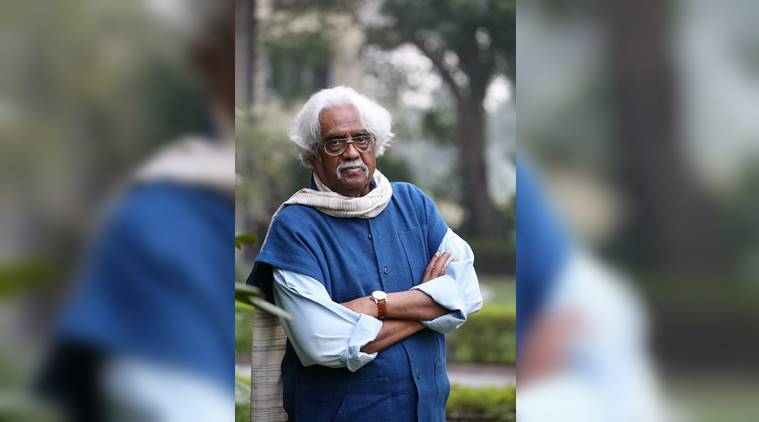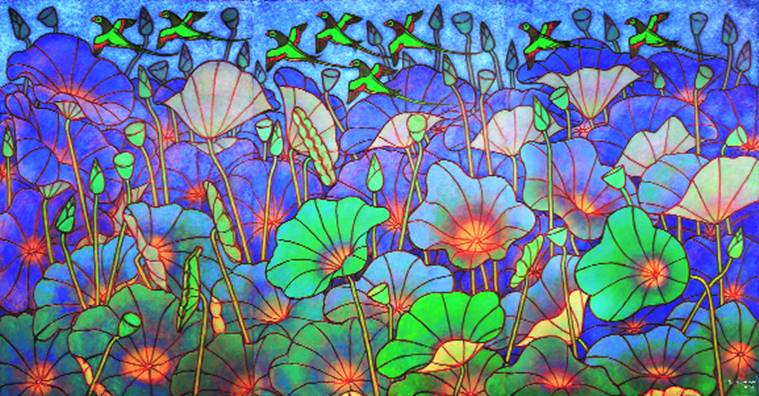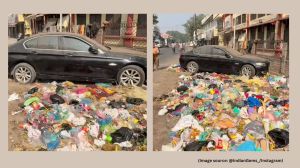‘Painting should not become political journalism’
Artist A Ramachandran, 84, on his ongoing solo show in Delhi, why he resisted a European influence on his art and moved away from social commentary.
 Roots, wings: Ramachandran. (Amit Mehra)
Roots, wings: Ramachandran. (Amit Mehra)
The lotus has been a recurring motif in your work since the 1990s — as it is in your current exhibition in Delhi, “The Changing Mood of the Lotus Pond and Insignificant Incarnations”. Why does this flower intrigue you?
The lotus is one of the most important motifs in Indian art. It has many connotations in Indian philosophy — as a part of the process of enlightenment, the basis of mandala images, or the pedestal on which goddess Lakshmi sits. Across South Asia, it is one of the most important flowers. But when I began painting the lotus, I was not thinking of these larger connotations. I used it as a metaphor for a larger quest in the 1991 series Urvashi Pururavas and the Lotus Pond. Over the years, it has become a part of my work. I initially turned to it at a time when I was moving away from my early period of social commentary. I was dissatisfied with the European elements that dominated my work and wanted to reconnect to my childhood and the environment that produced me.
What prompted this shift from political and social realism to more mythical portrayals? Yayati (1986) is considered a turning point in your practice. You faced a lot of criticism too for it.
After Yayati, for more than 15 years, I was an outcast in Indian art. I was swept away with a big broom. An artist told me I had pushed Indian art 100 years back, others accused me of being ‘decorative’. What needs to be understood is that Indian art has been decorative, it is an inherent character of Indians; we decorate our houses, our trucks; we don’t relate to the stark simplicity of European architecture.
When I moved to Delhi in the 1960s, I was working with Kumar Art Gallery on a monthly stipend of Rs 500. Krishen Khanna, Ram Kumar and Tyeb Mehta were my colleagues. All of them had studied art abroad, except me. They discussed European art, but I think I was saved from that period when the European influence was so overpowering, and that is what made me look at things differently.
The last incident that shook me up, though, took place in 1984, when I saw a group of people chasing a Sikh in front of my house in Delhi. They killed him. That is the first time I saw how gruesome man can be towards another man. It is all right to paint human miseries but do we really feel what it is? I started introspecting on the function of art, and developing a visual language that was based on an Indian art tradition which is also more contour-based. We used colour better than (Henri) Matisse. Look how we painted Krishna blue, the gopis green, without really bothering about skin colour.
 Ramachandran’s work from his new show at Vadehra Art Gallery. (Amit Mehra)
Ramachandran’s work from his new show at Vadehra Art Gallery. (Amit Mehra)
How has Kerala influenced your art practice? You were born in Attingal, and spent several years in Trivandrum.
My cultural milieu comes from Kerala. I have retained my sense of sarcasm, satire and humour that is innate to us. I feel Malayalam is suitable for satire, and I also bring that element into my portraits. My contemporaries were (filmmakers) G Aravindan, Adoor Gopalakrishnan, and each of us were searching for a new visual language. The first communist government was established by EMS Namboodiripad in Kerala (1957) when I had just finished college. It was dismissed, but they brought in remarkable land reforms, and changes in education. There was a movement from traditional Sanskritised scholarly literature to that of the people. A social consciousness crept into Malayalam literature and writers were looking at life around them.
You went to Santiniketan to study art in 1958. What were your impressions of the institution?
It was the only Indian art institution that was not following a course set by the British. As a student, I was largely influenced by Ramkinkar Baij, who had a certain modernism that is accepted even today. I still prefer his Santhal Family to his experiments with cubism. In the later years, I became more attached to Nandalal Bose. He is among the greatest intellectuals India has produced. He did paintings, murals, children’s books, stage design, among other things. He worked with his students, experimented with them. People talk of Paul Klee. I think Bose was far greater.
Since the 1980s, the Bhils in Rajasthan have been your muse.
I was never comfortable with the cityscape. People in the city are conditioned by societal norms and behaviour. We live in an artificial society, whereas the tribals have a more open society. In Kerala, I did not interact with the tribes. When I went to Santiniketan, we were asked to visit the Santhals in villages around. I was fascinated. They were poor but happy, knew how to smile, dance and laugh. I first interacted with the Bhils in the 1970s. Once I made an acquaintance with them, I would attend their ceremonies, watch them closely, sketch their life and rituals, and they became a part of my paintings. They live in complete harmony with nature.
We also often see you make an appearance in your work, as a spectator in the larger landscape, for instance.
When I was making Yayati, I had an urge to include myself in that vast panorama. We have the tradition of the sutradhar (narrator), and I became that. I realised it had tremendous possibilities. It is not a portrait but allows one to identify people with different characteristics.
You have also written and illustrated numerous books for children. In several of them, you use folk and traditional elements like Warli and Madhubani. What made you look at the medium?
Chameli (his wife) grew up in Santiniketan. I was a child in Kerala, very close to my grandparents, who would often tell me stories. I would climb on top of trees, skip across paddy fields, go on long walks with my grandfather. It was a world untouched by modernism and one where I learnt much more than my children who grew up in Delhi. We had a nuclear family and I would often tell them stories and watch their response. It is the stories they liked that appeared in books.
Even before I got married, I was a member of a writers’ cooperative society in Kerala and would illustrate children’s books with Aravindan that we would publish on Jawaharlal Nehru’s birthday. So, I had some training in illustrating children’s books. The decision to use elements of folk art came from my learning as a teacher. The folk traditions are expressive. Look at Ganga Devi (Madhubani artist). She is an artist as great as any other great artist. She painted simple forms that are highly communicative.
What is your view on socio-political commentaries in contemporary art?
Everyone has their own perspective but painting should not become political journalism. During a talk at Cleveland Museum of Art, US, I asked people: if somebody gave you Marcel Duchamp’s Fountain and you keep it in your house, will it add any value? Every work of art has an existence of its own. It has to live that life — it may commit suicide, live long or go places. I am not thinking about now. The question is what will happen 100 years later? There must have been so many artists in Rembrandt’s or Van Gogh’s time, but why does one man stand out?



- 01
- 02
- 03
- 04
- 05




























